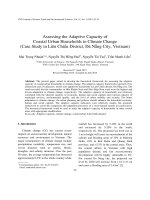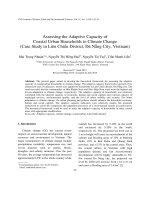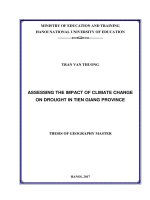Suggestions of farmers to mitigate the ill effects of climate change on agriculture in Dharwad district of Karnataka, India
Bạn đang xem bản rút gọn của tài liệu. Xem và tải ngay bản đầy đủ của tài liệu tại đây (153.48 KB, 4 trang )
Int.J.Curr.Microbiol.App.Sci (2018) 7(3): 1927-1930
International Journal of Current Microbiology and Applied Sciences
ISSN: 2319-7706 Volume 7 Number 03 (2018)
Journal homepage:
Original Research Article
/>
Suggestions of Farmers to Mitigate the Ill Effects of Climate Change on
Agriculture in Dharwad District of Karnataka, India
Huchhappa Gondali* and Dipak Kumar Bose
Department of Agricultural Extension & Communication, Sam Higginbottom University of
Agriculture, Technology and Sciences, Naini, Allahabad-211 007, U.P., India
*Corresponding author
ABSTRACT
Keywords
Suggestion, Climate
change, Agriculture
Article Info
Accepted:
16 February 2018
Available Online:
10 March 2018
Climate changes, such as changes in temperatures, the amount, intensity and distribution of
rainfall can have beneficial or adverse effects on world’s agriculture. The present study
was conducted in Dharwad districts of Karnataka state during 2016-17 to find out the
suggestions of the respondents to mitigate the ill effects of climate change on agriculture.
Descriptive research design was followed with a sample of 120 respondents selected
randomly. The findings revealed that majority of the farmers suggested insurance has to be
extended to all crops, followed by providing financial support for soil nutrient enrichment,
implementation of weather related insurance scheme effectively was suggested by the
above mentioned farmers. This was probably due to the lack of knowledge on scientific
practices and adaptation options by the farmers. Incentives/support for increasing the green
manuring, support price has to be given to all the crop produce based on cost of
cultivation, subsidies/compensation has to be given for the crops to make up the cost of
cultivation due to weather aberrations. This was probably due to price fluctuation in the
market. To minimize the ill effects of climate change on agriculture proper training on
scientific methods, demonstration and extension strategies to be followed by the
government, research station and extension functionaries.
Introduction
Global Warming is the increase of Earth’s
average surface temperature due to effect of
increase greenhouse gases, such as carbon
dioxide emission from burning fossil fuels or
from deforestation, which trap heat that would
otherwise escape from Earth. The United
Nations has identified two responses to
climate change. Mitigation of climate change
is by reducing the amount of greenhouse gases
in the atmosphere and adaptation to the
impacts of climate change. Practically, we are
unlikely to clean up the greenhouse gas
situation entirely through mitigation efforts, at
least reduce their further increase, thus some
adaptation will be necessary. Both adaptation
and mitigation are essential to reduce the
impacts of climate change.
Some changes in climate will affect
agriculture through their direct and indirect
effects on crops, soil, livestock, fisheries and
pest. Tropical countries are likely to be
affected more compared to the countries
situated in temperate regions. The burnt of
1927
Int.J.Curr.Microbiol.App.Sci (2018) 7(3): 1927-1930
environmental changes is expected to be very
high in India due to greater dependence on
agriculture, limited natural resources, alarming
increase in human and livestock population
changing pattern in land use and socioeconomic factors that pose a great threat in
meeting the food, fiber, fuel and fodder
requirement, There is a likelihood of
considerable impact on agriculture land-use
due to snow melt, availability of irrigation,
frequency and intensity of inter and intraseasonal droughts and floods soil organic
transformation, soil erosion and availability of
energy as a consequence of global warming
impacting agricultural production.
In order to understand how human beings
would respond to climate change, it is
essential to study people's perceptions of
climate and the environment in general
(Vedwan and Rhoades, 2001). Human
expectations regarding weather and climate
sometimes lead to perceptions of climate
change which are not supported by
observational evidences (Rebetcz, 2000). A
better understanding of how farmers’ perceive
climate change, ongoing adaptation measures,
and the factors influencing the decision to
adapt farming practices is needed to craft
policies and programmes aimed at promoting
successful adaptation of the agricultural sector
(Bryan et al., 2009).
Materials and Methods
The present investigation was conducted in
Taluk Kundagol of Dharwad district which
was selected purposively based on depending
upon extent of climate variation. The study
covered 12 villages and 120 respondents who
had more than 15 years of farming experience
selected randomly. Data were collected by
using pre-tested interview schedule by the
researcher himself. The data on socioeconomic aspects like education, age, family
type, land holding, occupation, income, mass
media exposure were collected. The
information was also gathered through
focused group discussion and observation
methods. The collected data were coded,
tabulated, classified and analysed by both
descriptive and inferential statistics to draw
the conclusion.
Results and Discussion
The results of the study with respect to socioeconomic profile of the respondents are
presented in Table 1. Table 1 indicated that
majority (51.67%) respondents were middle
aged followed by 29.17 per cent between 1835 years, 19.16 per cent respondents age was
above 51 years. The probable reason for such
distribution might be that majority of the
middle aged farmer’s perceived agriculture as
a profitable avenue. Majority of the
respondents (68.33%) were literate while
31.67 per cent were illiterate. Regarding of the
land holding majority (76.67%) of the
respondents are marginal and small farmers.
About the annual income, it was found that
majority (66.67%) of the respondents comes
under medium to semi medium income group,
20.00 per cent have high level of income,
52.50 per cent have medium level of mass
media exposure respectively. Similar findings
are also reported by Ahmad et al., (2013).
Table 2 indicates that the majority of the
respondents valuable suggestion given by
Insurance has to be extended to all crops
(85%) followed by Providing financial support
for soil nutrient enrichment (81.67%),
Incentives/support for increasing the green
manuring (77.5%), Support price has to be
given to all the crop produce based on cost of
cultivation (72.5%), Subsidies/compensation
has to be given for the crops to make up the
cost of cultivation due to weather aberrations
(69.17%).
1928
Int.J.Curr.Microbiol.App.Sci (2018) 7(3): 1927-1930
Table.1 Socio demographic profile of the respondents
Sr. no
Personal profile
Age
Young (Between 18 - 35 years)
1.
Middle (Between 36 - 50 years)
2.
Old (Above 51 years)
3.
Education
Illiterate
1.
Primary school (1st to 4th)
2.
Middle (5th-7th)
3.
High school (8th-10th)
4.
PUC
5.
Graduate and above
6.
Land holding
Marginal farmers (Up to 1.0 ha)
1.
Small farmers (1.1 to 2.0 ha)
2.
Medium farmers (2. 1 to 4 ha)
3.
Big farmers (More than 4 ha)
4.
Annual income
Low (up to Rs. 17,000/-)
1.
Medium (Rs. 17,001-34,000)
2.
Semi-medium (Rs. 34,001-51,000)
3.
High (above Rs. 51,000/-)
4.
Extension contact
Low (<12)
1.
Medium (12-14)
2.
High (>14)
3.
Mass media exposure
Low (<17)
1.
Medium (17-21)
2.
High (>21)
3.
Frequency
Percentage
35
62
23
29.17
51.67
19.16
38
34
25
12
09
2
31.67
28.33
20.83
07.50
13.33
1.67
38
54
24
4
31.67
45.00
20.00
3.33
16
42
38
24
13.33
35.00
31.67
20.00
30
64
26
25.00
53.33
21.67
25
63
32
20.83
52.50
26.67
Table.2 Suggestions given by the respondents to mitigate the ill effects of climate change
Sl. No.
1
2
3
4
5
6
7
8
9
Farmers suggestions
Early warning has to be given to the farmers about environmental changes
Creating awareness to the farmers about appropriate adaptation measures against
climate change
Development department should ensure supply of production inputs at appropriate
time in the villages
Subsidies/compensation has to be given for the crops to make up the cost of
cultivation due to weather aberrations
Insurance has to be extended to all crops
Providing financial support for soil nutrient enrichment
Incentives/support for increasing the green manuring
Support price has to be given to all the crop produce based on cost of cultivation
Creating awareness/support for adoption of organic farming technologies
1929
F (%)
56 (46.67)
69 (57.5)
Rank
IX
VIII
75 (62.5)
VII
83 (69.17)
V
102 (85)
98 (81.67)
93 (77.5)
87 (72.5)
78 (65)
I
II
III
IV
VI
Int.J.Curr.Microbiol.App.Sci (2018) 7(3): 1927-1930
Creating awareness/support for adoption of
organic
farming
technologies
(65%),
Development department should ensure
supply of production inputs at appropriate
time in the villages (62.5%), Creating
awareness to the farmers about appropriate
adaptation measures against climate change
(57.5%), Early warning has to be given to the
farmers about environmental changes
(46.67%). Similar findings are also reported
by Pande and Akermann (2010).
It is concluded from the present study that the
majority respondents belongs from medium
level of socio-economic status. They have
suggested that insurance has to be extended to
all crops, providing financial support for soil
nutrient enrichment, incentives/support for
increasing the green manuring, support price
has to be given to all the crop produce based
on cost of cultivation. They also suggested
that subsidies/compensation has to be given
for the crops to make up the cost of
cultivation due to weather aberrations.
Government should take proper steps on crop
insurance, subsidies, financial, cost of
cultivation price as well as time to time traing,
demonstration and proper extension strategies
should be followed to minimize the ill effect
of climate change in agriculture.
References
Ahmad J, Alam D and Hassen S (2013)
Impact of Climate Change on
Agriculture and Food Security in India.
pp. 131-136.
Bryan, E., Deressa, T. T., Gbetibouo, G. A.
and Ringler, C., 2009, Adaptation to
climate change in Ethiopia and South
Africa: options and constraints.
Environ. Sci. Policy, 12 (4): 413-426.
Pande, P. and Akermann, K., 2010,
Adaptation of small scale farmers to
climatic risks in India. Sustained India,
B-4 GK II, New Delhi, India.
Rebetcz, M., 2000, Public expectations as an
element of human perceptions of
climate change. Climatic change,
Springer, Netherlands 32: 495-509.
Vedwan, N. and Rhoades, R. E., 2001,
Climate change in the western
Himalayas of India: A study of local
perceptions and response. Climate Res.,
19: 109-117.
How to cite this article:
Huchhappa Gondali and Dipak Kumar Bose. 2018. Suggestions of Farmers to Mitigate the Ill
Effects of Climate Change on Agriculture in Dharwad District of Karnataka, India.
Int.J.Curr.Microbiol.App.Sci. 7(03): 1927-1930. doi: />
1930









